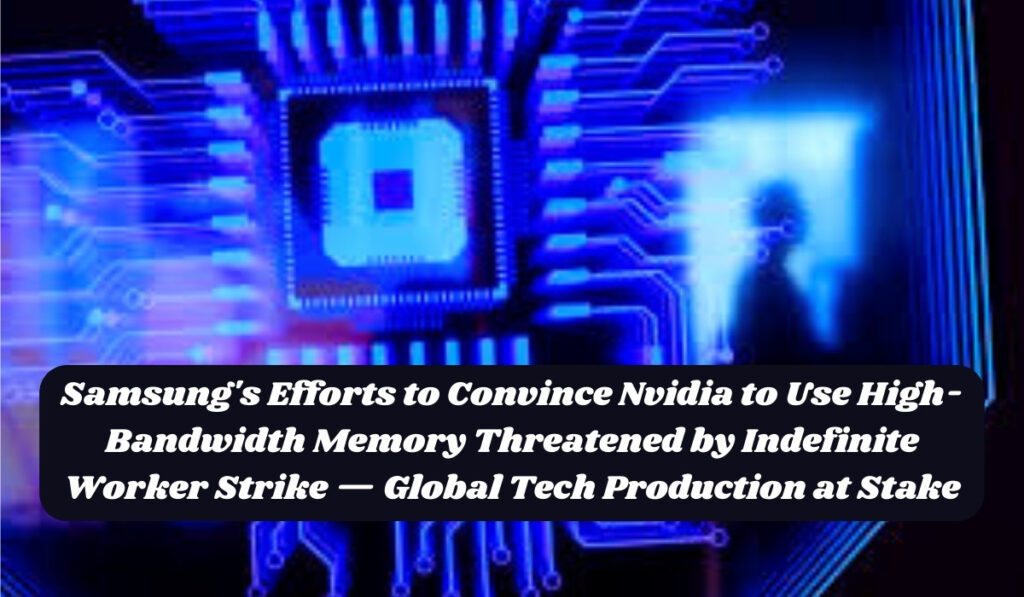Introduction
Samsung has been on a relentless quest to push the boundaries of high-bandwidth memory (HBM) technology. With Nvidia on board, the stakes are high, and the potential benefits for the tech world are monumental. But as workers at Samsung’s HBM manufacturing plants declare an indefinite strike, this ambitious project faces unprecedented challenges. This article delves into the intricacies of HBM, the collaboration between Samsung and Nvidia, and the potential global ramifications of the ongoing labor strike.
Background on High-Bandwidth Memory (HBM)
HBM has been a game-changer in the world of tech. But what exactly is it?
What is HBM?
High-bandwidth memory is a type of memory interface designed to dramatically increase the speed and efficiency of data transfer between processors and memory chips. Unlike traditional memory modules, HBM stacks memory chips vertically, reducing the distance data has to travel.
Advantages of HBM
The perks of HBM are numerous. Let’s break them down.
Performance Boosts
HBM offers significant performance enhancements. By stacking memory vertically, HBM achieves higher bandwidth compared to traditional memory, enabling faster data processing and improving overall system performance.
Energy Efficiency
Beyond speed, HBM is also more energy-efficient. Its design reduces power consumption, making it an attractive option for companies looking to build powerful yet eco-friendly devices.
Samsung’s Role in HBM Development
Samsung has been at the forefront of HBM innovation. But how did they get here?
History of Samsung and HBM
Samsung’s journey with HBM began years ago, with substantial investments in research and development. They have consistently been a leader in memory technology, pushing the envelope with each new generation of HBM.
Collaboration with Nvidia
The partnership between Samsung and Nvidia is a match made in tech heaven. Nvidia, known for its cutting-edge graphics processors, stands to benefit immensely from Samsung’s HBM expertise, promising to deliver unprecedented performance in its products.
The Current Labor Strike
Just as things were looking up, an unforeseen obstacle emerged: a labor strike at Samsung’s HBM manufacturing plants.
Reasons Behind the Strike
Understanding why the workers are striking is crucial to grasping the situation.
Worker Demands
Workers are demanding better wages, improved working conditions, and more job security. They argue that despite the increasing profits from HBM technology, their compensation and working conditions have not improved proportionately.
Negotiation Failures
Negotiations between the workers and management have repeatedly failed, leading to an indefinite strike. The communication breakdown has only exacerbated the situation, leaving both sides at an impasse.
Impact on Samsung’s Production
The strike has brought Samsung’s HBM production to a grinding halt. This disruption not only affects Samsung but also has a ripple effect on its partners, including Nvidia.
Nvidia’s Perspective
For Nvidia, HBM is not just a luxury but a necessity. Here’s why.
Importance of HBM for Nvidia
Nvidia’s cutting-edge GPUs rely heavily on HBM to deliver the high performance their customers expect. The adoption of HBM allows Nvidia to stay ahead of the competition and continue pushing the boundaries of what’s possible in graphics processing.
Potential Setbacks Due to the Strike
The indefinite strike poses significant risks for Nvidia. Delays in HBM production could lead to postponed product launches, supply shortages, and ultimately, financial losses.
Global Tech Production at Risk
The implications of the strike extend far beyond Samsung and Nvidia. Here’s how.
Ripple Effects on Other Tech Companies
Many tech companies rely on Samsung’s HBM for their products. The production halt could lead to a domino effect, disrupting supply chains and delaying product releases across the industry.
Long-Term Consequences
If the strike continues, the long-term consequences could be severe. Companies might seek alternative suppliers, potentially shifting the balance of power in the memory technology market.
Possible Resolutions
So, what’s next? How can this crisis be resolved?
Mediation and Negotiations
Mediation could be a viable solution, bringing in a neutral third party to facilitate negotiations between the workers and management. Finding common ground is essential to end the strike and resume production.
Government Intervention
In some cases, government intervention might be necessary. Authorities could step in to mediate the dispute or offer incentives to resolve the strike.
Conclusion
The indefinite strike at Samsung’s HBM manufacturing plants has cast a shadow over the promising collaboration with Nvidia. The future of HBM and its impact on global tech production hangs in the balance. As negotiations continue, the tech world watches closely, hoping for a resolution that will allow Samsung and Nvidia to resume their groundbreaking work.

